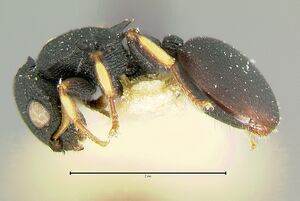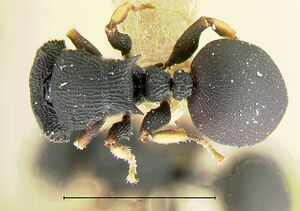Cataulacus chapmani
| Cataulacus chapmani | |
|---|---|

| |
| Scientific classification | |
| Kingdom: | Animalia |
| Phylum: | Arthropoda |
| Class: | Insecta |
| Order: | Hymenoptera |
| Family: | Formicidae |
| Subfamily: | Myrmicinae |
| Tribe: | Crematogastrini |
| Genus: | Cataulacus |
| Species: | C. chapmani |
| Binomial name | |
| Cataulacus chapmani Bolton, 1974 | |
Nothing is known about the biology of Cataulacus chapmani.
Identification
A member of the taprobanae group. Closely related to Cataulacus reticulatus and its immediate allies, Cataulacus chapmani is separated by its lack of an occipital crest, which is present in other species of the complex, The sculpturation of the alitrunk approximates closely to that of Cataulacus catuvolcus but this species has a marginate first gastral tergite as well as a distinct occipital crest. (Bolton 1974)
Keys including this Species
Distribution
Latitudinal Distribution Pattern
Latitudinal Range: 9.3023° to 9.3023°.
| North Temperate |
North Subtropical |
Tropical | South Subtropical |
South Temperate |
- Source: AntMaps
Distribution based on Regional Taxon Lists
Indo-Australian Region: Philippines (type locality).
Distribution based on AntMaps
Distribution based on AntWeb specimens
Check data from AntWeb
Countries Occupied
| Number of countries occupied by this species based on AntWiki Regional Taxon Lists. In general, fewer countries occupied indicates a narrower range, while more countries indicates a more widespread species. |

|
Estimated Abundance
| Relative abundance based on number of AntMaps records per species (this species within the purple bar). Fewer records (to the left) indicates a less abundant/encountered species while more records (to the right) indicates more abundant/encountered species. |

|
Biology
|
Castes
  
| |
| . | Owned by Museum of Comparative Zoology. |
Nomenclature
The following information is derived from Barry Bolton's Online Catalogue of the Ants of the World.
- chapmani. Cataulacus chapmani Bolton, 1974a: 75, fig. 30 (w.m.) PHILIPPINES (Negros, Luzon).
- Type-material: holotype worker, 17 paratype workers, 3 paratype males.
- Type-locality: holotype Philippines: Negros I., Dumaguete, 30.iv.1924 (J.W. Chapman); paratypes: 14 workers with same data, 2 males with same data but without date and 500 ft, 1 worker with same data but 28.iv.1932, 1 worker, 1 male with same data but undated and numbered 405, 1 worker Philippines: Luzon I., Lamao (no collector’s name).
- Type-depositories: MCZC (holotype); BMNH, MCZC, USNM (paratypes).
- Status as species: Bolton, 1995b: 138.
- Distribution: Philippines (Luzon, Negros).
Unless otherwise noted the text for the remainder of this section is reported from the publication that includes the original description.
Description
Worker
Holotype. TL 4.9, HL 1.14, HW 1.34, CI 118, EL 0.42, OI 31, IOD 1.08, SL 0.60, SI 45, PW 1.06, AL 1.34, MTL 0.66.
Occipital crest absent, the vertex not separated from the occiput. Sides of head behind eyes denticulate, the occipital corners with a small, broad but low triangular tooth. Margins of frontal carinae arcuate, not crenulate nor denticulate; preocular tooth small and very broad basally. Margins of alitrunk not denticulate except for a single very small prominence upon the outer margin of each propodeal spine, on its apical half. Mesonotum separated from propodeum by a narrow but distinct notch or constriction. Propodeal spines long, tapering and acute apically. Petiole in profile with the steeply back-sloping anterior face meeting the sloping dorso-posterior face in an acute angle which is visible as a transverse ridge in dorsal view. Sides of first gastral tergite not marginate.
Sculpturation of a fine dense reticulate-puncturation everywhere which overlies any rugulation which may be present. Head finely reticulate-rugose, the cross-meshes tending to fade out in front of the level of the anterior margins of the eyes so that only the longitudinal component remains. Dorsum of pronotum reticulate-rugose but the remainder of the dorsal alitrunk with only fine, low, regular and more or less parallel longitudinal rugae. Upper part of propodeal declivity between the spines with one or two weak, transverse rugae, the remainder reticulate-punctate only. First gastral tergite with a very close and fine reticulate-puncturation and numerous short, irregular longitudinal rugulae.
Dorsal surfaces of head and alitrunk without erect hairs but the margins of the former with some minute hairs projecting laterally. Margins of alitrunk also with a few minute, projecting hairs. Dorsal surfaces of legs and gaster with scattered small hairs, best seen on the apical third of the latter.
Paratypes. TL 4.4 – 4.8, HL 1.04 – 1.16, HW 1.26 – 1.36, CI 117 - 121, EL 0.40 – 0.42, OI 30 - 32, IOD 1.02 – 1.10, SL 0.56 – 0.60, SI 44 - 45, PW 1.00 – 1.10, AL 1.20 – 1.38, MTL 0.60 – 0.68 (10 measured).
As holotype but some show the development of two or three low, blunt denticles upon the pronotal margin. In one of the smaller specimens erect hairs are completely absent from the first gastral tergite and the transverse rugae of the upper portion of the propodeal declivity may be very faint or even absent.
Male
Paratypes. TL 4.6 – 4.8, HL 0.96 – 1.00, HW 1.14 – 1.16, CI 116 - 119, EL 0.38 – 0.40, OI 33 - 35, IOD 0.94 – 0.98, SL ca 0.54, SI 46 - 47, PW 0.96 – 0.98, AL 1.52 – 1.60, MTL ca 0.70 (2 measured).
Occipital crest absent, sides of head behind eyes denticulate. Occipital corners with a well developed, broadly triangular tooth. Frontal groove indistinct, not reaching the median ocellus. Margins of pronotum and propodeum irregular but not denticulate, the propodeal spines very short and broad, blunt apically. Notauli completely absent or with a very weak impression marking the position of the anterior arms. First gastral tergite not marginate laterally. Head finely reticulate-rugose, the interspaces reticulate-punctate, and with the cross-meshes tending to disappear in front of the level of the eyes so that only the longitudinal component remains. Dorsal surfaces of pronotum and propodeum and the scutellum reticulate-rugose and punctate, the scutum more definitely longitudinally rugose but with some feeble cross-meshes. Gaster and the apical portions of the parameres finely and densely reticulate-punctate. Distribution of hairs as in worker.
Type Material
Holotype worker, PHILIPPINES: Negros Island, Dumaguete, 30.iv.1924 J., W. Chapman) (Museum of Comparative Zoology).
Paratypes. 14 workers, same data as holotype (MCZC, The Natural History Museum, National Museum of Natural History), 2 males, same data as holotype but without date of collection and stating '500 ft' (MCZ). 1 worker, same locality and collector as holotype but dated 28.iv.32 (MCZ). 1 worker and 1 male, same data as holotype but undated and bearing the number '405' (BMNH). 1 worker, PHILIPPINES: Luzon Island, Lamao, no further data (MCZ).



